Reading view
New updates available
openmediavault 7.4.14
- Add rudimentary support for the obsolete file systems
reiserfsandreiser4. The userland apps must be installed manually via the Debian packagesreiserfsprogsandreiser4progs. - Issue #1859: Fix a problem when disabling the user home directory.
- Issue #1862: Use LC_ALL environment variable instead of LANG.
openmediavault-bcache 7.0
- Initial release
openmediavault-diskstats 7.0.2
- Issue #1862: Use LC_ALL environment variable instead of LANG.
openmediavault-k8s 7.4.2
- Use K3S v1.31.2+k3s1 by default. Existing installations won’t be upgraded automatically. To force an upgrade, create the file
/var/lib/openmediavault/upgrade_k3sand runomv-salt deploy run k3s. - Fix Traefik port configuration issue.
- Issue #1862: Use LC_ALL environment variable instead of LANG.
openmediavault-md 7.0.3
- Issue #1862: Use LC_ALL environment variable instead of LANG.
openmediavault-onedrive 7.1.3
- View log messages under
Diagnostics | System Logs | Logs.
CapibaraZero: a student’s journey in reinventing hacking tools with Arduino
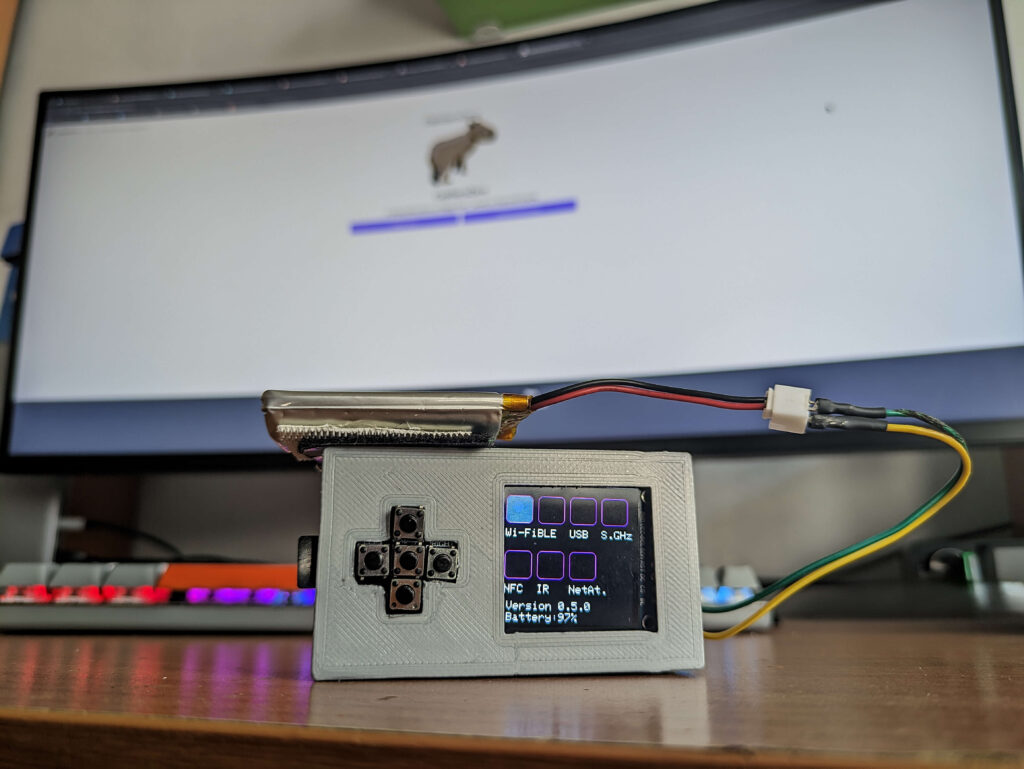
Inventive, open-source, and cost-effective – these words perfectly describe CapibaraZero, a multifunctional security and hacking tool developed by young innovator Andrea Canale.
Inspired by the popular Flipper Zero, a portable device used to interact with digital systems, Canale sought to create a more accessible, Arduino-based alternative.
The original Flipper Zero, known for its ability to read, copy, and emulate RFID tags, NFCs, and even remote control signals, has become a valuable tool for tech enthusiasts. Canale’s CapibaraZero captures much of this functionality but adds his own unique approach and vision.

A student’s vision for an accessible, open-source alternative
A passionate student from the University of Turin, Canale began working on CapibaraZero while still in high school, driven by the desire to build a tool that didn’t just replicate Flipper Zero’s capabilities but improved upon them through the power of open-source design.
CapibaraZero, named after Canale’s favorite animal, combines an Arduino Nano ESP32 with custom-designed PCB boards, making it adaptable and expandable. With sections dedicated to Wi-Fi®, Bluetooth®, infrared, NFC, and even network attacks, CapibaraZero allows users to experiment with multiple forms of wireless communication and digital security protocols in a way that’s affordable and accessible.
A tool for experimentation and learning
What makes CapibaraZero remarkable is not only its functionality but also Canale’s dedication to ensuring it remains open-source, user-friendly, and continually evolving. With additional modules for advanced features like Sub-GHz communication and network attacks (such as ARP poisoning and DHCP starvation), CapibaraZero empowers enthusiasts to expand the tool’s potential beyond traditional hacking devices.
Canale has even provided an in-depth tutorial for anyone interested in building or exploring CapibaraZero on Arduino’s Project Hub. He also is sharing the project on a dedicated website and public GitHub repository. Check out the details and join Canale’s journey to push the boundaries of DIY security tools!
The post CapibaraZero: a student’s journey in reinventing hacking tools with Arduino appeared first on Arduino Blog.
New AMD Zen 5 Perf Events Going Into Linux 6.13
Raspberry Pi Pico 2 W Launches For $7
Fwupd 2.0.2 Allows Updating Firmware On Many More Devices
Beelink EQ14 mini PC features Intel N150 quad-core “Twin Lake” processor, built-in power supply
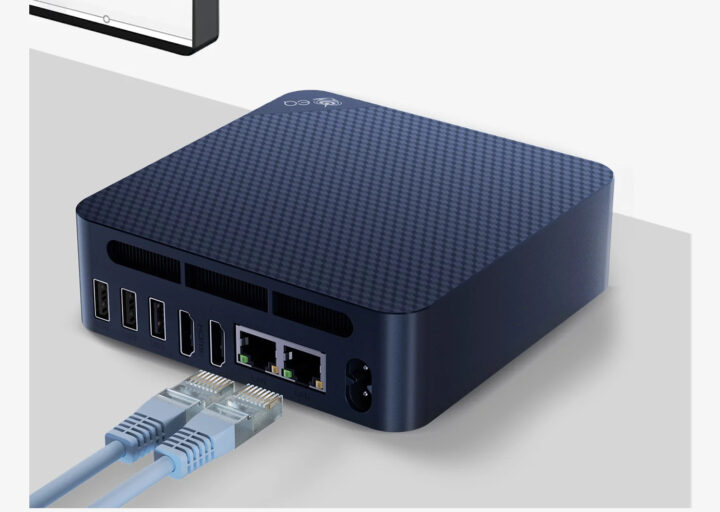
Last month we noted the Intel Processor N150, Processor N250, and Core i3-N355 Alder Lake-N Refresh CPUs were found in the upcoming ASUS NUC 14 Essential mini PC family, but availability was unclear. The Beelink EQ14 is the first Intel N150 mini PC which can be purchased today on either AliExpress (with EU plug) or Amazon for $182 and up for Black Friday and Cyber Monday 2024. Beelink calls the CPU family “Twin Lake” instead of “Alder Lake-N Refresh”, but we can’t confirm that since the N150 has not been officially launched yet and it’s not listed on Intel Ark. The computer is equipped with 16GB DDR4 memory, a 512GB NVMe SSD, two HDMI ports, two gigabit Ethernet ports, WiFi 6, etc… It also comes with a more unusual feature: a built-in AC power supply, something we previously saw in the Beelink EQ13 with an Intel N200/N100 CPU. Beelink EQ14 [...]
The post Beelink EQ14 mini PC features Intel N150 quad-core “Twin Lake” processor, built-in power supply appeared first on CNX Software - Embedded Systems News.
Fably bedtime storyteller
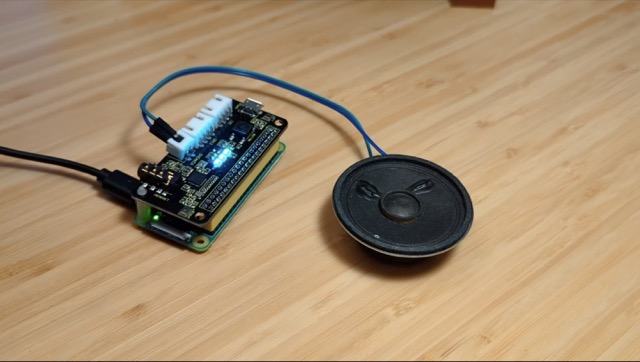
Servers operated by Flux - true privacy and decentralization for all users
Servers operated by Flux — true privacy and decentralization for all users
Published: Nov 25, 2024
- Welcome, Flux — the new servers in v6.2-beta.1!
- What's the problem?
- Using two operators improves connection privacy.
- SimpleX decentralization compared with Matrix, Session and Tor.
- What's next for SimpleX network decentralization?
Welcome, Flux – the new servers in v6.2-beta.1!
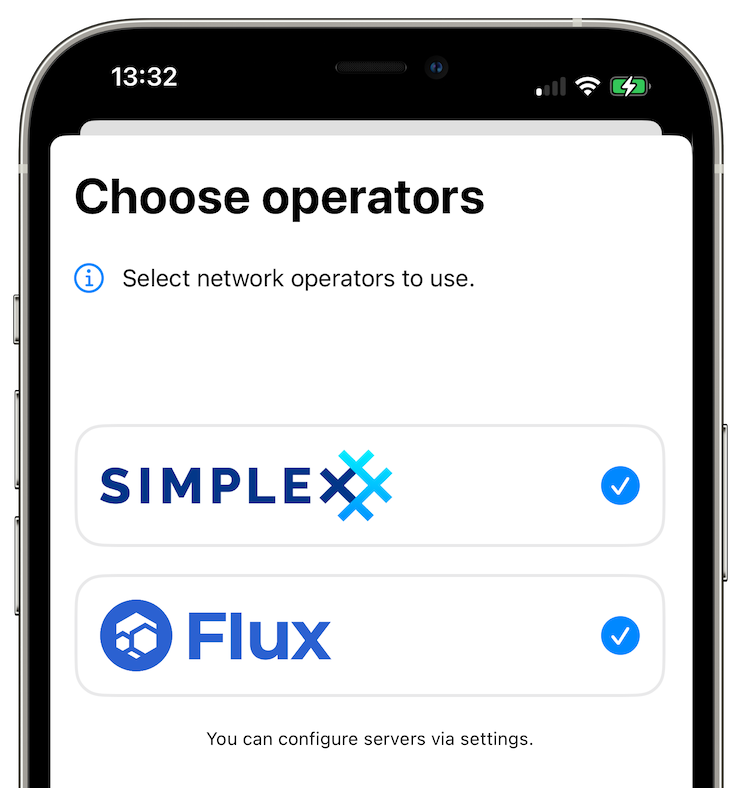
Flux is a decentralized cloud infrastructure that consists of user-operated nodes [1]. With this beta release all SimpleX Chat users can use pre-configured Flux servers to improve metadata privacy and decentralization.
We are very grateful to Daniel Keller, CEO and co-founder of Flux, for supporting SimpleX network, and betting on our vision of extreme decentralization of communication. Flux investing their infrastructure in our vision is a game changer for us and our users.
Download new mobile and desktop SimpleX apps from TestFlight (iOS), Play Store, our F-Droid repo or GitHub.
Read on to learn why it is important and how using several operators improves metadata privacy.
What's the problem?
SimpleX network is fully decentralized, without any central component or bootstrap nodes — you could use your own servers from day one. While there is no full list of SimpleX network servers, we see many hundreds of servers in public groups.
But a large number of SimpleX app users use the servers pre-configured in the app. Even though the app randomly chooses 4 servers in each connection to improve privacy and security, prior to v6.2 for these users the servers were operated by the same company — ourselves.
Our open-source code that we are legally bound to use doesn't provide any metadata that could be used to learn who connects to whom. But the privacy of users' connections still depends on us honouring our promises and privacy policy. Flux servers in the app improve that.
Using two operators improves connection privacy
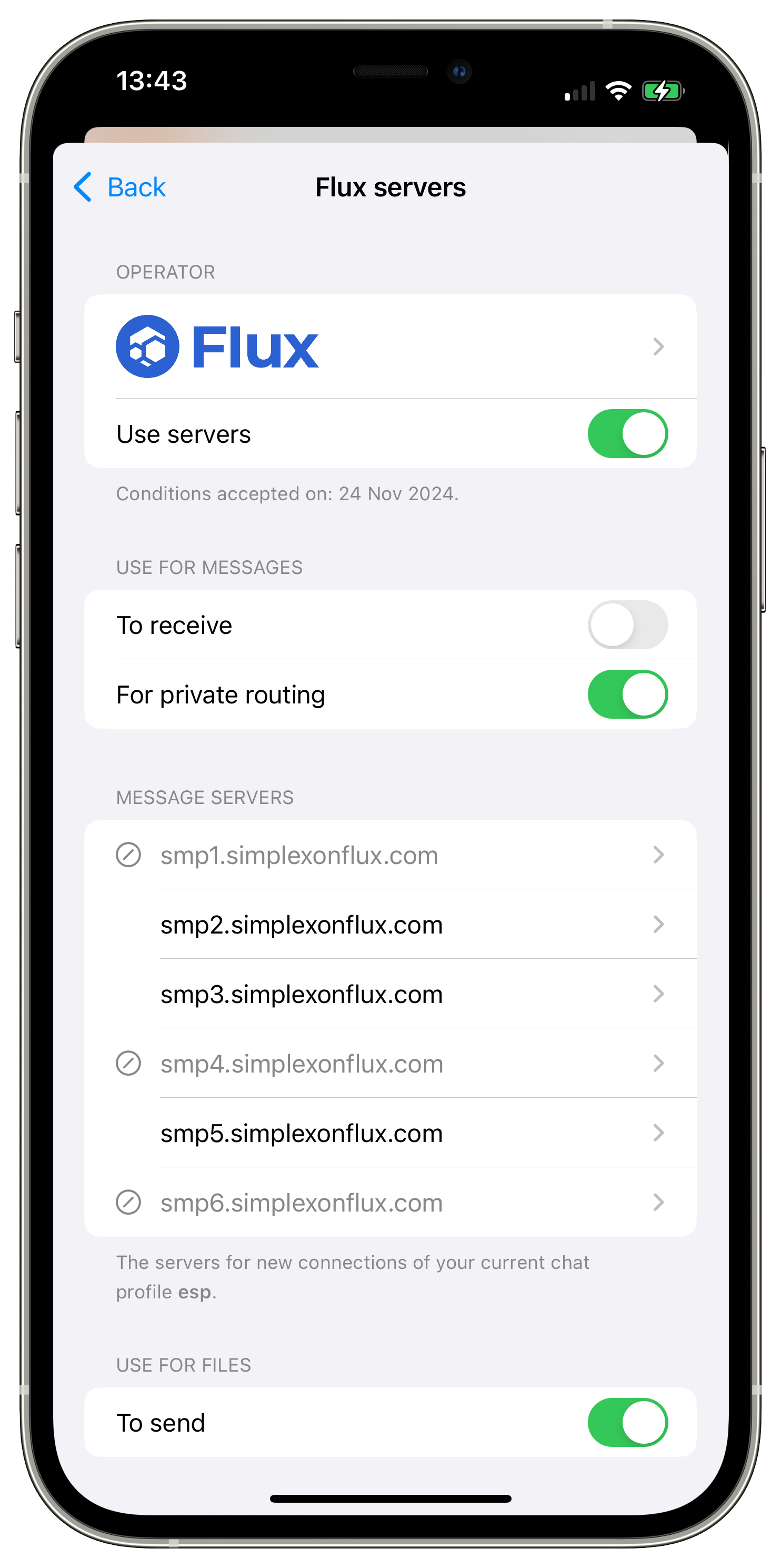
To ensure that the users' metadata from different servers cannot be combined to discover who talks to whom, the servers in each connection have to be operated by different independent organizations.
Before this version the app was choosing servers randomly. Now, when both SimpleX Chat and Flux servers are enabled it will always choose servers of different operators in each connection to receive messages and for private message routing, increasing metadata privacy for all users.
Flux servers are configured as opt-in, and the privacy policy and conditions of use that apply to Flux servers are the same as for SimpleX Chat servers, to make it simple for the users.
To improve connection privacy by using Flux servers all you have to do is to enable Flux once the app offers it, or later, via Network & servers settings, and accept that the same conditions apply.
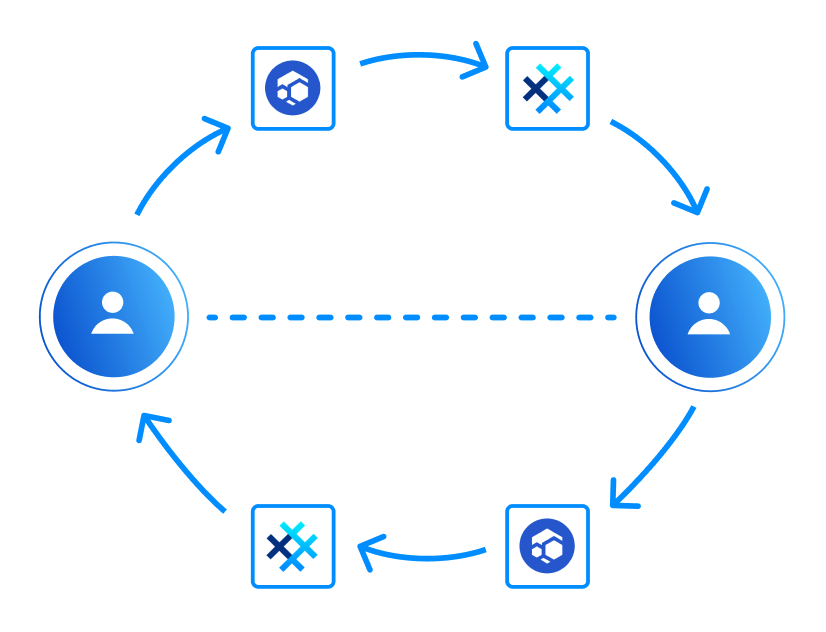
By default, if both Flux and SimpleX servers are enabled in this version, you will be using SimpleX Chat servers to receive messages, Flux servers to forward messages to SimpleX Chat servers, and the servers of both to forward messages to unknown servers. We will enable Flux to receive messages by default a bit later, or you can change it now via settings.
Any additional servers you add to app configuration are treated as belonging to another operator, so they will also be used to improve connection privacy, together with pre-configured servers, unless you disable them.
SimpleX decentralization compared with Matrix, Session and Tor
SimpleX network decentralization model is different from other decentralized networks in several important aspects.
| Communication network | SimpleX | Matrix | Session | Tor-based |
|---|---|---|---|---|
| Full decentralization | ✅ | - | - | - |
| No user profile identity | ✅ | - | - | - |
| Connection privacy | ✅ | - | ✅ | ✅ |
| Server operator transparency | ✅ | ✅ | - | - |
Full decentralization
Fully decentralized networks do not have a central component, bootstrap nodes or any global shared state, like in cryptocurrency/blockchain-based communication networks. The presence of any central component or shared state introduces an attack vector that undermines privacy and security of the network.
No user profile identity
User profile identities, even if it is only a random number or a long-term key, undermine privacy of users connections, because in some cases they may allow network operators, observers and users to find out who talks to whom.
Most communication networks rely on fixed user profile identities. It includes Matrix and communication networks with onion routing.
SimpleX network design avoids the need for profile identities or keys, while still allowing optional long-term addresses for users and groups for convenience. It protects users from being discovered and approached by malicious parties, and many family users chose to use SimpleX with children because of it.
Connection privacy
SimpleX network has private message routing (2-hop onion routing) — it prevents server operators from discovering who connects to whom via network traffic metadata. Onion routing used in Tor-based messengers and in Session also hides it. But because neither Tor nor Session users have knowledge about who operates servers, in some cases the clients may connect via the servers controlled by one entity, that may learn the IP addresses of both parties.
Statistically, if traffic metadata from 2% of onion network servers is available to an attacker, and the client chooses servers randomly, after about 1750 of such choices the probability of choosing attacker's servers as both entry and exit nodes, and connection privacy being compromised becomes over 50% [2].
Matrix network does not provide connection privacy, as not only user identity exists, it is tied to a specific server that knows all user connections and a part of user's contacts connections. What is worse, Element — the most widely used Matrix app — offers the servers of only one organization to create an account, resulting in some degree of network centralization.
Server operator transparency
Operator transparency means that network users know who operates the servers they use.
You may argue that when the operators are known, the servers data can be requested by the authorities. But such requests, in particular when multiple operators are used by all users, will follow a due legal process, and will not result in compromising the privacy of all users.
With Tor and Session networks such legal process becomes impossible, and some users may see it as advantage. But nothing prevents the attackers, both criminal and corporate- or state-funded, to compromise the privacy of Tor or Session users by running many servers, or by purchasing traffic metadata from the existing server owners — there are no legal conditions that prohibit server owners of these networks to share or sell traffic data.
Because of that, we see operator transparency in SimpleX network as a better trade-off for privacy of most users than operator anonymity provided by Session and Tor. You can see privacy of network participants as a zero sum game — for the end users to have it, server operators should be known.
What's next for SimpleX network decentralization
SimpleX network is designed for extreme decentralization — not only users are distributed across network operators, as happens with federated networks, but each conversation will be relying on servers of 4-6 independent operators, and these operators will be regularly and automatically changed in the near future.
We believe that the only viable commercial model is freemium — a small share of paying users, who have better service quality and additional features, sponsors free users. This model doesn't have downsides of exploitative "provide service, sell data" approaches, that technology monopolies practice, and it also doesn't have problems of cryptocurrency blockchains, that have shared and immutable state, and also have regulatory problems.
To provide this extreme decentralization with freemium model we will create the system of payments allowing server operators to receive money for infrastructure certificates that will be used with any other participating network operators without compromising privacy of the paying users. You can read about this model here. We will be writing more about it as this development progresses.
SimpleX network
Some links to answer the most common questions:
How can SimpleX deliver messages without user identifiers.
What are the risks to have identifiers assigned to the users.
Technical details and limitations.
Please also see our website.
Please support us with your donations
Huge thank you to everybody who donated to SimpleX Chat!
Prioritizing users privacy and security, and also raising the investment, would have been impossible without your support and donations.
Also, funding the work to transition the protocols to non-profit governance model would not have been possible without the donations we received from the users.
Our pledge to our users is that SimpleX protocols are and will remain open, and in public domain, so anybody can build the future implementations of the clients and the servers. We are building SimpleX platform based on the same principles as email and web, but much more private and secure.
Your donations help us raise more funds — any amount, even the price of the cup of coffee, makes a big difference for us.
See this section for the ways to donate.
Thank you,
Evgeny
SimpleX Chat founder
[1] You can also to self-host your own SimpleX servers on Flux decentralized cloud.
[2] The probability of connection being de-anonymized and the number of random server choices follow this equation: (1 - s ^ 2) ^ n = 1 - p, where s is the share of attacker-controlled servers in the network, n is the number of random choices of entry and exit nodes for the circuit, and p is the probability of both entry and exit nodes, and the connection privacy being compromised. Substituting 0.02 (2%) for s, 0.5 (50%) for p, and solving this equation for n we obtain that 1733 random circuits have 50% probability of privacy being compromised.
Also see this presentation about Tor, specifically the approximate calculations on page 76, and also Tor project post about the changes that made attack on hidden service anonymity harder, but still viable in case the it is used for a long time.
Raspberry Pi Pico 2 W on sale now at $7
Today, our epic autumn of product launches continues with Raspberry Pi Pico 2 W, the wireless-enabled variant of this summer’s Pico 2. Built around our brand new RP2350 microcontroller, featuring the tried and tested wireless modem from the original Pico W, and priced at just $7, it’s the perfect centrepiece for your connected Internet of Things projects.

RP2350: the connoisseur’s microcontroller, redux
When we launched our debut microcontroller, RP2040, way back in 2021, we couldn’t have imagined the incredible range of products that would be built around it, or the uses that the community would put them to. Combining a symmetric pair of fast integer cores; a large, banked, on-chip memory; rich support for high-level languages; and our patented programmable I/O (PIO) subsystem, it quickly became the go-to device for enthusiasts and professional engineers seeking high-performance, deterministic interfacing at a low price point.

RP2350 builds on this legacy, offering faster cores, more memory, floating point support, on-chip OTP, optimised power consumption, and a rich security model built around Arm’s TrustZone for Cortex-M. It debuted in August on Pico 2, on the DEF CON 32 badge (designed by our friends at Entropic Engineering, with firmware and a gonzo sidewalk badge presentation by the redoubtable Dmitry Grinberg), and on a wide variety of development boards and other products from our early-access partners.
Wireless things
Many of the projects and products that people build on top of our platforms — whether that’s our Linux-capable Raspberry Pi computers, our microcontroller boards, or our silicon products — answer to the general description “Internet of Things”. They combine local compute, storage, and interfacing to the real world with connectivity back to the cloud.
Raspberry Pi Pico 2 W brings all the power of RP2350 to these IoT projects. The on-board CYW43439 modem from our friends at Infineon provides 2.4GHz 802.11n wireless LAN and Bluetooth 5.2 connectivity, and is supported by C and MicroPython libraries. Enthusiasts benefit from the breadboard-friendly Pico form factor, while our upcoming RM2 radio module (already in use on Pimoroni’s Pico Plus 2 W) provides a route to scale for professional products which have been prototyped on the platform.

More to come
We’re very pleased with how Pico 2 W has turned out. And, where the Pico 1 series ended with Pico W, we have a few more ideas in mind for the Pico 2 series. Keep an eye out for more news in early 2025.
The post Raspberry Pi Pico 2 W on sale now at $7 appeared first on Raspberry Pi.
$7 Raspberry Pi Pico 2 W board launched with 2.4 GHz WiFi 4 and Bluetooth 5.2 wireless module
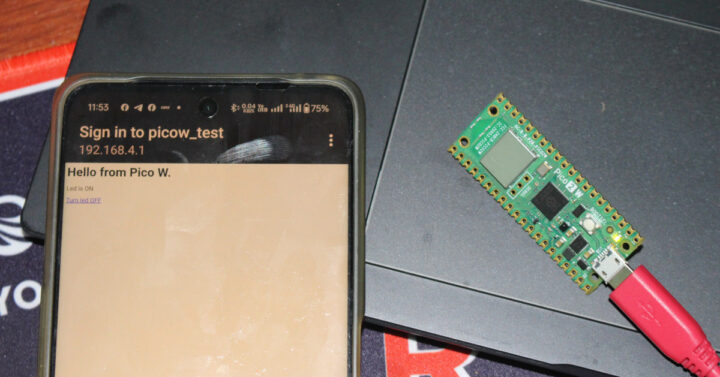
As expected, the Raspberry Pi Pico 2 W – the wireless version of the Raspberry Pi Pico 2 – is now available with an extra 2.4GHz WiFi 4 and Bluetooth 5.2 wireless module at an official price of $7. We’ll go through the specs and perform a mini review in this post trying out both WiFi and Bluetooth code samples. It’s not the first Raspberry Pi RP2350 with WiFi and Bluetooth we’ve seen, as Pimoroni introduced the Pico Plus 2 W board with an RP2350B MCU and Raspberry Pi RM2 Wi-Fi and Bluetooth module, and iLabs launched the Challenger+ RP2350 WiFi6/BLE5 board relying on ESP32-C6 wireless module. However, the Raspberry Pi Pico 2 W is the official board, is cheaper, and will certainly be the most popular/widely used. Raspberry Pi Pico 2 W specifications Raspberry Pi Pico 2 W specifications: SoC – Raspberry Pi RP2350 CPU Dual-core Arm Cortex-M33 @ [...]
The post $7 Raspberry Pi Pico 2 W board launched with 2.4 GHz WiFi 4 and Bluetooth 5.2 wireless module appeared first on CNX Software - Embedded Systems News.
This Week in Beagle #6

Hello everyone. Another light week here. Let’s go over everything.
BeagleY-AI SD Card support
While hacking on my BeagleY-AI, I found that my HP SD card did not work with BeagleY-AI for some reason. On digging a bit further, some SD cards were not working on BeagleY-AI due to some issues with signal voltage switching on the am62x platform. This has now been fixed, as seen in the following patch series. By switching out the Linux kernel to mainline, I was able to get the HP SD card to work. So, the SD card compatibility of BeagleY-AI will improve soon.
BeagleBoard Rust Imager
BeagleBoard Rust imager got lots of love this week.
AppimageLauncher Problem
As pointed out by Jason here, the BeagleBoard Rust imager appimage is not usable with AppimageLauncher. The issue seems to be that appimagetool uses ZSTD compression now, while AppimageLauncher does not support it yet. Moreover, it seems like AppimageLauncher makes the appimage unusable. For now, the recommendation is to either remove AppimageLauncher or at least deactivate it for the BeagleBoard Rust imager.
More information regarding the upstream issue can be found here.
SD Card Flashing Performance Improvements
While the SD card flashing worked, it was much slower than the original bb-imager. After some tinkering with the buffer size while flashing and using parallel decompression of xz images, SD card flashing should be much faster (flashing time decreases by 57%).
It is still a bit slower than the original bb-imager (about 1 min), but it seems related to the internals of QFile, so that would be much more work than just a day.
Debian Packages
BeagleBoard Rust imager now builds Debian packages in CI using cargo-deb. While the goal is to eventually have an upstream package using debcargo, there is not much point until bb-imager-rs hits v1.0.0. Additionally, since debcargo only seems to support building stuff already present in cartes.io, it does not seem suitable for experimental builds (although I could be wrong about that).
Experimental Builds
Builds from the latest main branch are now pushed to Package Registry rather than just being stored as build artifacts. This makes grabbing the latest development version of bb-imager-rs much simpler.
Note: Only the most recent build is kept around.
Ending Thoughts
This was it for this week. Hopefully, this helps bring transparency regarding where the development efforts are concentrated, and how the community can help. Look forward to next update.
Helpful links
The post This Week in Beagle #6 appeared first on BeagleBoard.
Phoronix Premium Cyber Week Sale To Better Enjoy Our Linux Hardware Reviews & News
nRF54L15 DK: A Development Kit for nRF54L15, nRF54L10, and nRF54L05 SoCs with Bluetooth, Thread, and Zigbee

The nRF54L15 DK is a development kit designed to evaluate the wireless SoCs of the nRF54L15, nRF54L10, and nRF54L05 wireless SoCs. These SoCs support multiple wireless protocols, including Bluetooth Low Energy, Bluetooth Mesh, Matter, Thread, Zigbee, and 2.4GHz proprietary protocols, with data rates of up to 4Mbps. The kit integrates the nRF54L15 SoC and provides emulation capabilities for the nRF54L10 and nRF54L05, enabling flexible testing and development across the nRF54L Series. The nRF54L series SoCs differ in memory configurations to meet various application requirements. The nRF54L15 includes 1.5 MB of non-volatile memory (NVM) and 256 KB of RAM for high-performance applications. The nRF54L10 features 1.0 MB of NVM and 192 KB of RAM for mid-range use cases, while the nRF54L05 offers 0.5 MB of NVM and 96 KB of RAM for entry-level designs requiring fewer resources. The kit is supported by the nRF Connect SDK and tools, providing access to [...]
The post nRF54L15 DK: A Development Kit for nRF54L15, nRF54L10, and nRF54L05 SoCs with Bluetooth, Thread, and Zigbee appeared first on CNX Software - Embedded Systems News.
Take Your CNC Projects to the Next Level with the Genmitsu 4040-PRO MAX and Genmitsu APP (Sponsored)

Don’t miss this opportunity to upgrade your CNC experience with the Genmitsu 4040-PRO MAX CNC Router and the Genmitsu APP with WiFi Module—a powerful duo designed for precision, performance, and convenience. 4040-PRO MAX: Revolutionizing Precision and Performance The Genmitsu 4040-PRO MAX is engineered to deliver top-tier CNC routing with exceptional accuracy and power. Its 400 x 400mm working area and 710W spindle make it perfect for both intricate woodworking and demanding metal engraving tasks. Enhanced Stability & Rigidity: This router’s upgraded Z-axis and linear guide rail system ensure unmatched precision and reduce vibrations for consistent results. Increased Z-axis Clearance: A 100mm pass height accommodates larger materials, making it versatile for diverse projects. Powerful Spindle: The 710W spindle cuts effortlessly through tough materials, earning rave reviews from users for its reliability and efficiency. Comprehensive Compatibility: This router offers endless customization and is compatible with most 4040 accessories, including routers, four-axis modules, [...]
The post Take Your CNC Projects to the Next Level with the Genmitsu 4040-PRO MAX and Genmitsu APP (Sponsored) appeared first on CNX Software - Embedded Systems News.
LILYGO to Launch ESP32-Based Gizmo with E-Paper Display, LoRa, and MagSafe Charging
Waveshare Development Boards Feature RP2350 with 100 Mbps Ethernet or 1.14-Inch LCD
TANGO-7010 Series Featuring Intel 12th Gen i3 to i9 Cores and Triple 2.5GbE Ports
SparkFun introduces Quadband GNSS RTK Breakout board with Quectel LG290P module for high-precision navigation

SparkFun has released the Quadband GNSS RTK Breakout featuring the Quectel LG290P module designed for high-precision real-time kinematic (RTK) applications. It supports GPS, GLONASS, Galileo, BDS, QZSS, and NavIC constellations, with the ability to simultaneously receive signals from L1, L2, L5, and L6/E6 frequency bands. The module includes support for SBAS augmentation systems (e.g., WAAS, EGNOS, GAGAN) and PPP services (e.g., BDS PPP-B2b, QZSS CLAS), delivering reliable positioning with fast convergence times for precision navigation tasks. The breakout board offers a compact design (43.2 x 43.2mm) and multiple expansion options including 24 PTH pins, dual 4-pin JST Qwiic connectors, three UART interfaces, a USB-C connector, and additional PTH pins for BlueSMiRF/Serial-to-UART. With its RTK support and advanced GNSS capabilities, the board is ideal for applications requiring high-accuracy positioning and robust navigation performance. Previously, we covered several GNSS boards including the SparkFun GNSS L1/L5, u-blox EVK-LEXI-R10, and Conexio Stratus Pro and [...]
The post SparkFun introduces Quadband GNSS RTK Breakout board with Quectel LG290P module for high-precision navigation appeared first on CNX Software - Embedded Systems News.